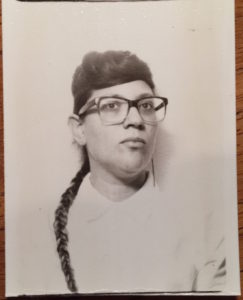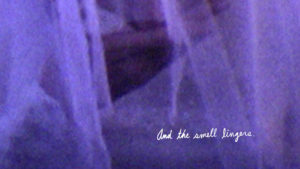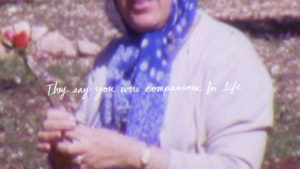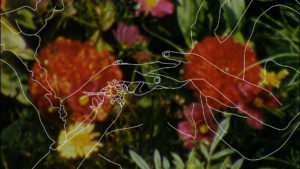Showcase Filmmaker Spotlight: Irit Reinheimer
Showcase Filmmaker Spotlight: Irit Reinheimer
By Travis Trew, Programming Associate

Philadelphia-based artist Irit Reinheimer was trained in sculpture, but gradually found her way to documentary and experimental films. Her work often combines disparate elements, including text, animation, and her late father’s 8mm home movies. Of Origins: Hannah is the first part of a planned trilogy exploring the lives and afterlives of three Jewish, German women in the early and mid-20th century. In Hannah, Reinheimer communes with Hannah Karminski, a feminist activist who was killed at Auschwitz in 1942.
PFS: Of Origins: Hannah is just the first part in what’s meant to be a three-part series. Could you describe the overall themes of the series?
IR: The series is called Of Origins, and it’s a way for me to explore where I come from, my lineage, and what I inherited. Rather than focusing on my traditional, biological family I chose three Jewish, German women who were around in the 1900s. One of them is Hannah, who the first film is about. The second person is my great-grandmother Emma. And the third person is Bertha Pappenheim, who both of the other women worked with. These are not meant to be biographies. I create a relationship with each of them as a way to explore different parts of my identity. Each short film is a love letter that’s created based on archives, photos, things I read. It’s about creating a lineage and a connection with these three women.
PFS: How did you come to Hannah Karminski’s story in particular?
IR: Hannah’s story drew me in because of her queerness. Although some queers do come from queer families, I didn’t. I wasn’t necessarily looking for her. I was researching Bertha Pappenheim, who there are several books about, and her name came up many times Bertha Pappenheim was Hannah’s mentor, and so there was information about her in relation to Bertha. But it’s also mentioned that Hannah had this life partner Paula. So I also started digging into her relationship with Paula. A little bit about Bertha Pappenheim and why there are books about her: she founded the League of Jewish Women, a German Jewish feminist organization in 1904. She ran a home for single mothers and orphan girls. That’s where my great-grandmother worked and lived. And Hannah worked with Bertha as part of this Jewish feminist organization called the League of Jewish Women. So they’re all related to each other in a way. I found them through each other.
PFS: Is there a lot of information about Hannah’s relationship with Paula, or is it pretty much limited to the fact that they were life partners?
 IR: There might be, but a lot of the information about Hannah’s life is in German and I don’t speak or read German. I don’t know what the books about Hannah contain, in terms of her relationship with Paula, although they both worked together also. The Leo Baeck Archive in New York does have a lot of letters that were written to Hannah or from Hannah, and some of them do contain information about Paula. And I’ve gotten little bits of it translated, but there’s probably a lot more information that I just haven’t been able to access.
IR: There might be, but a lot of the information about Hannah’s life is in German and I don’t speak or read German. I don’t know what the books about Hannah contain, in terms of her relationship with Paula, although they both worked together also. The Leo Baeck Archive in New York does have a lot of letters that were written to Hannah or from Hannah, and some of them do contain information about Paula. And I’ve gotten little bits of it translated, but there’s probably a lot more information that I just haven’t been able to access.
PFS: What is the research process like on a project like this?
IR: One thing that was important to me in the process of making this film was to work on the writing first. In the past I would get distracted and waste time looking for footage and imagery before I knew what I wanted to say, so I decided it would be a good challenge for me to really focus on the writing. I started finding anywhere that Hannah was mentioned in books about Bertha Pappenheim. I also toured the Leo Baeck Archives, and found photos online. I went to a psychic. In some ways it was very much about building a relationship with Hannah, which I think is why I decided to make the film in the form of a letter, because in my head I was having conversations with her. And so I would go between these different elements and clues, some of which I speak of in the film itself. Some of the letters that I could find in the archives I would just use Google translate to try to roughly translate. I did find some folks to translate bits of it for me. I would explore what an image might contain, I’d follow footnotes, and I’d do some Internet research. I really tried to gather as much as I could about someone on whom there wasn’t a bunch of information compiled for me.
PFS: The film contains some footage shot in Berlin? Did you actually go there?
IR: There is some footage from Berlin, which a friend of a friend shot for me. One of the things I explored was that in Berlin there are all these blocks on the sidewalk. It’s a project that an artist did where the name, location, and year of different individuals who had died during the Holocaust. Once I saw in my research that both Paula and Hannah had one, I knew I wanted that footage. So I was like, “Here are the two locations, here’s what I’m imagining, this is what the script says.” And asked her to get the footage for me. Then I went to Berlin in May and showed the film there at a festival.
PFS: Oh nice. Were you able to visit Paula and Hannah’s blocks when you were there?
IR: Yes! I visited them and did rubbings of the stones. So now I have a sort of copy of each of them.
PFS: When did you start using 8mm home movies? They’re your father’s, right?
 IR: This was my father’s 8mm home movie footage, and I first saw them as VHS transfers that my brother did sometime in the 90s. It was not all in chronological order. It was all over the place. there’s maybe about two hours of it. My father died when I was 18 years old and I probably started looking at the VHS tapes five or six years later when I worked on my first documentary Young, Jewish, and Left and we thought maybe we could find some b-roll in there. We didn’t use any of that footage, but I really loved it. The first time I used the footage was in a film I made with Sara Zia Ebrahimi. A film called How the Bridge Works, which was a movie that was about our fathers and after that point I decided I was interested to see how many different ways I could use this footage. In some ways it can feel like I’m in collaboration with my father, using his work and reimagining it. In this film I use my mother and sister as a stand in for Hannah and Paula, to help the view imagine her a little more. It brings them to life.
IR: This was my father’s 8mm home movie footage, and I first saw them as VHS transfers that my brother did sometime in the 90s. It was not all in chronological order. It was all over the place. there’s maybe about two hours of it. My father died when I was 18 years old and I probably started looking at the VHS tapes five or six years later when I worked on my first documentary Young, Jewish, and Left and we thought maybe we could find some b-roll in there. We didn’t use any of that footage, but I really loved it. The first time I used the footage was in a film I made with Sara Zia Ebrahimi. A film called How the Bridge Works, which was a movie that was about our fathers and after that point I decided I was interested to see how many different ways I could use this footage. In some ways it can feel like I’m in collaboration with my father, using his work and reimagining it. In this film I use my mother and sister as a stand in for Hannah and Paula, to help the view imagine her a little more. It brings them to life.
PFS: Do you have more information on your great-grandmother?
IR: No, there’s not really that much information on her. Bertha Pappenheim is where there’s the most information and in some ways I’m using her to fill in the facts about other people. I do have maybe 30 seconds of footage of my great-grandmother from when she came to the US, which is very exciting. And I do have a lot of photographs, but I don’t have that much information. I think no one asked her much information by the time she came here. So I’ll use whatever I can find. But really, I have the information I need to know about her life. The next film will explore more about colonialism through the story of my name.
PFS: Can you tell me a little about the animations used in the film?
 IR: Lindsey Martin did all those animations, through a process called rotoscoping. Lindsey and I recorded live footage and then from the frames of the live footage we took frames and exported them into Photoshop. Then Lindsey spent about 100 hours tracing the outline of the images that we wanted and then returning them back into Premiere for us to edit. Even though maybe there’s a minute or two of footage in the film, there’s a good 100-plus hours of work.
IR: Lindsey Martin did all those animations, through a process called rotoscoping. Lindsey and I recorded live footage and then from the frames of the live footage we took frames and exported them into Photoshop. Then Lindsey spent about 100 hours tracing the outline of the images that we wanted and then returning them back into Premiere for us to edit. Even though maybe there’s a minute or two of footage in the film, there’s a good 100-plus hours of work.
PFS: That’s crazy.
IR: Yeah, it’s very time consuming. I mean all animation is time consuming but this is the one of the easier way to do animation. And again I think, similar to the home movies, this is another way of bringing these people to life. The two parts of the film that are animated are based on photos that I wanted to bring to life. And this felt like the easiest way to do that.
PFS: Are you using rotoscoping for the next two Of Origins films as well?
IR: I haven’t decided. That’s one of the things I want to explore: What parts of the style that I used in Hannah do I want to use in other films? I know that I’m going to continue using the form of the letter, and continue having the text on screen, hand-written rather than a narration. I will be using some of the 8mm footage again. There will probably be some sort of animation or manipulation of the footage, but what exactly it will look like I’m not sure yet. I’m interested in maybe changing that up.
Of Origins: Hannah will screen on Thursday, August 10th at the Prince Theater’s Black Box as part of Philly Film Showcase, an exhibition supporting new work by talented, up-and-coming local filmmakers.